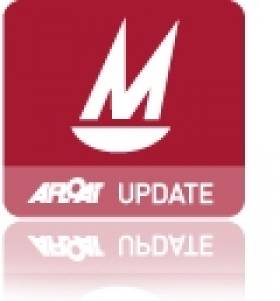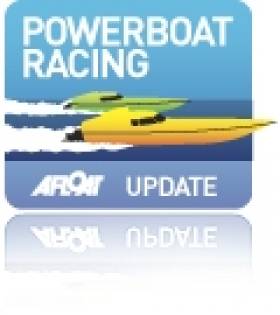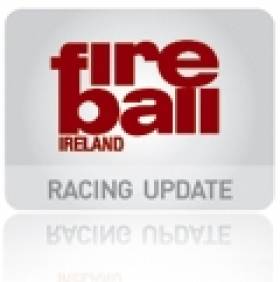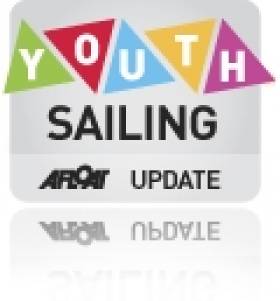Displaying items by tag: World Championships
Five Represent Ireland at Canoe Slalom World Cup
Eoin Rheinisch joins four others representing Ireland at the Canoe Slalom World Cup today.
Ciarán Heurteau, Patrick Hynes, Hannah Craig and Aisling Conlan round out the squad competing in Leipzig, Germany.
Rheinisch told The Irish Times that he was "shattered" after a week of hard training in Bratislava, aiming for the World Championships and Olympic qualification there in September.
"But they are the kind of sessions I need to be getting intermittently,” he said.
Irish Teams Selected for Team Racing World Championships
After the first round the home team, the "George Gladiators" were demonstrably the leading senior team. They won all their races, and in all but one race finished in first and second place. The "Supertroopers", mainly University of Limerick graduates, were second with 5 wins and UCD1 4 wins. These 3 teams proceded to the second round, sailing each other once. In order to qualify UCD1 needed to beat both other teams. Unfortunately, they lost their first race to the "Gladiators". The "Gladiators" then relaxed, loosing their only race of the day to the Supertroopers, who then beat UCD1.
In the Youth event, Schull1 won 3 races, Schull2 2 races. This was enough to ensure selection.
As a result of these trials the Irish Team Racing Association will be recommending the following teams to represent Ireland (subject to meeting all eligibility requirements) at the ISAF World Team Racing Championships, to be sailed in Schull,West Cork in August:
Ireland 1
Marty O'Leary, Brian Fenlon, Sam Hunt, Jodie-Jane Tingle, Andrew Fowler, Rachel Guy
Ireland 2
Darragh O'Connor, Hannah Herlihy, Kevin Stollard, Rachel O'Brien, George Kingston, Tom Martin
Ireland Youth 1
Connor Miller, Ellen O' Regan, Oisin O'Driscoll, Katie Moynihan, Jay Jay Stacy, Kaspar Snashall
Ireland Youth 2
Fionn Lyden, Tomas O'Sullivan, Darragjh McCormack, Mark Hasset, Pearse O'Flynn, Gleb Romantchik
Afloat's March/April Issue Out Next Week!
Is there no end to the achievements of Irish boaters against seemingly impossible odds?
The winter may have been a time of hibernation for some of us but as the stories in Afloat's March/April issue will bear out Irish sailors have been battling the elements all winter long.
James Carroll competed in January's Sydney-Hobart offshore race and, much closer to home, Paul A. Kay journeyed through snow and ice in December from Dun Laoghaire to a new marina on Valentia Island.
As if to prove a point that we're down but not out, a winter of results on foreign waters includes a win in the Mirror World Championships in Australia and a top Olympic result in Florida, USA.
They are gutsy performances from youth teams that shows, if nothing else, the next generation of Irish sailors is really up for a fight. All this plus lots, lots more on news-stands next week!
Selected contents from Ireland's only boating magazine include:
News
Surveyors Issue Boat Launch Warning, Buoyant Dinghies Buck the Market, Ice Diving in Ireland, German U-Boat Rediscovered in Cork Harbour, an Historic Trophy for South Pacific Dream Cruise, MGM open in Cork, Hugh Mockler joins Crosshaven Boatyard plus lots, lots more.
News Focus
A new masterplan for Dun Laoghaire harbour is badly needed but it needs buy in from all those that use it
Going Offshore
The tenth Dun Laoghaire to Dingle offshore race was launched in style
Marine Conference
Combating the downturn was the focus of a unique marine gathering on both sides of the Irish sea.

Gear Review
New dinghy gear, a new Crosshaven boot from Dubarry, a new raincoat for girls and an upgrade for Musto's MPX.

This Island Nation
The decision to shut down the fog signals was based on a detailed risk assessment. Tom MacSweeney on the loss of fog horns
Sailor of the Year
Anthony O'Leary of Cork is the Afloat.ie/Irish Independent "Sailor of the Year" in celebration of his outstanding achievements afloat nationally and internationally.
Tall Ships
W M Nixon looks at the realities of national sail training in the 21st Century.
Tall Ship Conference
Ireland could yet have a tall ship to replace the Asgard II and the Lord Rank, if a new group formed to press for a replacement is successful
Racing update
Ulstermen's World Title, Topper worlds for Dun Laoghaire, Two Irish campaigns line up for Figaro Race, SB3 Sailors Cry Foul at Dun Laoghaire Parking Fees and an Irish entry in the Moth worlds in Australia, Irish Mini 6.50 Campaign in Prospect.

Youth Worlds preview
Results achieved abroad this Winter are the backbone for further Irish youth
success

Figaro Preview
Two fledgling Irish La Solitaire du Figaro campaigns edged closer to the start line last month
Volvo Dun Laoghaire Regatta
Volvo Dun Laoghaire regatta has taken in 22 entries six months ahead of the first race of the biggest regatta in Irish sailing.

Fireball Worlds preview
Dun Laoghaire's Noel Butler intends to continue his winning run in the Fireball class this season but the year ahead doesn't look so easy as the World Championships come to Sligo
Sovereigns cup preview
Up to 30 Quarter tonners will be at the Sovereigns Cup this year including one from New Zealand.
Shiver to deliver
A journey through snow and ice from Dun Laoghaire to Valentia Island
Sydney-Hobart Race
Outside of the Volvo Ocean Race, the Sydney Hobart is one of the world's most challenging offshore races. James Carroll Raced it in January.
Inland
As the cuts begin to bite, it may be time to look at the British direction for our waterways, writes Brian J Goggin
Dubarry Nautical Crossword
Soundings
A Google aerial photo proves useful navigating for Baldoyle Estuary
- Anthony O'Leary
- Dun Laoghaire
- Tom MacSweeney
- Harbour
- MGM Boats
- Asgard II
- World Championships
- Dinghies
- Olympic
- Cork Harbour
- Valentia
- Mirror
- Dingle
- youth
- Lord Rank
- Island Nation
- Hugh Mockler
- Dubarry
- Tall ship
- brokerage
- sydneyhobart
- fog horn
- moth
- Mini 6.50
- Uboat
- Fireball worlds
- Sovereigns
- James Carroll
- Paul A. Kay
- Crosshaven Boatyard
- Baldoyle
- MPX
- W M Nixon
Ten Irish Sign up for Torquay SB3 World Champs
But top ranked Irish performer Ben Duncan, who races from Howth Yacht Club is entered under his native New Zealand flag.
Seriously Bonkers (Martin Cuppage), Bad Kilcullen (Jerry Dowling) and Cathy MacAleavey's Bluebird are among Dun Laoghaire boats to enter so far. The full entry list is here.
The event will be hosted by the Royal Torbay Yacht Club, UK from 16 – 20 May 2011.
Representatives from fourteen nations will compete in the World Championships. The host nation field an entry of over seventy boats. Entries come from as far afield as Australia and South Africa. Ireland, France, The Netherlands, Portugal, Greece, Switzerland, Belgium, Germany, Ukraine and Russia will all be represented in Torquay in May.
The three Laser SB3 World Champions, Geoff Carveth (2008 Champion, Dun Laoghaire), Craig Burlton (2009 Champion, Cascais) and Jerry Hill (2010 Champion, Torbole) will all compete for the 2011 Championship title.
Carveth, Burlton and Hill are all British and so far the Laser SB3 World Championship has not been won by another nation. Will 2011 see the trophy slip from the Brits grip?
Australian sailing man of the moment, Nathan Outteridge, will compete with Laser SB3 Class President, Dave Cheyne in Torquay in May. Outteridge is twice 49er World Champion, current Moth World Champion and recent winner of the Audi King of Docklands and Audi Victoria Week in the Laser SB3. Fellow Australian Glenn Bourke returns to the class for the Championship.
South Africa’s Roger Hudson will compete in his fourth Laser SB3 World Championship and will no doubt be determined to better his current hatric of second places. Hudson has sailed each of the previous World Championships with a different helm; 2008 David Hudson (father), 2009 Taariq Jacobs and 2010 Iain Ainslie. It is yet to be announced which members of the Race Ahead Foundation will sail with Hudson in 2011.
In preparation for the World Championships, the Royal Torbay Yacht Club will host the Torbay Open, 30 April – 2 May and the Pre World Championship 12 – 13 May. These two events will provide a great opportunity for a number of keen teams from across Europe to travel to the UK and sail on the waters of Tor Bay prior to the World Championships.
“We’re really looking forward to hosting the event at the Club, I sail in the fleet so it’s great to be involved in delivering this event. We’re delighted with the size and quality of the entry list and look forward to extending the entry if necessary,” explained Event Organiser Adrian Peach.
The Laser SB3 Class is proud to be one of the most tightly restricted one design keelboat classes in the world with little variation from the builder’s final product permitted. With minimal maintenance, easy to trail and low campaign costs, the class thrives on its philosophy of providing inclusive, high intensity, great fun and easily attainable, quality racing for its members.
Further news and developments can be followed HERE.
Dun Laoghaire Trio Stay Mid-Fleet at Dragon Worlds
Belfast Pair lie Fourth at Mirror Worlds
Ross Kearney and Max Odell lie sixth overall after seven races at the Mirror World Championships in Albany, Australia. The Belfast sailors, who won the European Championships when they were held in Sligo last Summer, are up against strong competition from a strong Aussie squad.
Day 1 saw the dominant Aussie National winner, Paul Taylor, leading (6 points) ahead of the Pilipino crew of Balladares & Chavez (7 points) but a British crew, Millie Newman and Jessica Rust, are leading after six races. More HERE.
Irish Powerboat Racers Take to World Stage
Irish powerboat racers have taken to the world stage in the southern hemisphere for the first time. (SCROLL DOWN FOR PHOTOS)
Keith Plummer, Lee Casey and Colin Gaffney from Dublin, all members of the Buccaneer Powerboat Club and Sean Dillon and Gary Hogg from Clare, members of the Irish Offshore Powerboat Racing Club took part in the UIM P750 World Championships South Africa last week.
On the ground the reports were that even though the Irish competitors had their mechanical setbacks they kept pushing hard. When it came to the rough stuff in the surf they really shined, gaining a lot of respect from their fellow competitors.
Sean Dillon & Gary Hogg had two wins and a second in the surf discipline and finished fourth overall in the championships. Mechanical setbacks denied Colin Gaffney and co-driver Bongani Ndesi, a world Championship medal to accompany his European Championship medal won at the UIM P750 European Championship at Killaloe in October.
All five have reported that it was a great experience and that taking part showed them what a wonderful sport this is and being part of the UIM family. They all said how proud they were to be Irish and the first competitors with an ISA Powerboat Racing Licence to Race in South Africa.
The P750 class has gone from strength to strength in Ireland and 2010 saw a well-supported national Championship, the P750 Europeans being held in Ireland and Irish Competitors competing in the World Championships.
Pictures below by Paul Bedford/www.actionimages.co.zaColin Gaffney Boat No 21, Keith Plummer and Lee Casey From Dublin Boat No 22, Sean Dillon and Gary Hogg from Clare Boat No 49. Sean and Gary were the top Irish team being placed fourth.
Fireballs Gear up for Worlds with New Video
Disappointing End for Irish Lasers
Things unravelled for Dun Laoghaire sailor Matthew O'Dowd towards the end of the Laser Worlds in Largs, Scotland. Once the fleets were split into Gold, Silver and Bronze, O'Dowd's run of good fortune seemed to hit a brick wall. A 69th was followed by a black flag, and the fourth race in the final race saw him come home 40th. A third place in the penultimate race showed that O'Dowd was still capable of cutting it at the top, but with too many doubl-digit results, O'Dowd saw first top five, then top ten, then top twenty drift away. However, 33rd in a Gold Fleet of 73 is still a good result in such a competitive fleet, however consolations like that will not go far.
Alan Ruigrok followed O'Dowd in 44th, with Ross Vaughan in 49th. Ruth Harrington was top girl, 17th in the Silver Fleet, with Saskia Tidey finishing 34th.
Full results are HERE.
In the Standard Rig Europeans, Chris Penney kept himself in the golf fleet, finishing 55th overall. Results pdf is attached.







































































